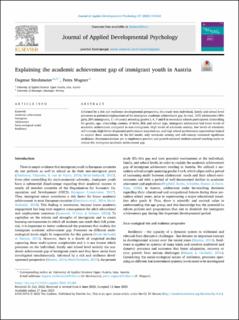| dc.contributor.author | Strohmeier, Dagmar | |
| dc.contributor.author | Wagner, Petra | |
| dc.date.accessioned | 2023-09-14T13:06:04Z | |
| dc.date.available | 2023-09-14T13:06:04Z | |
| dc.date.created | 2023-06-30T13:39:45Z | |
| dc.date.issued | 2023 | |
| dc.identifier.citation | Strohmeier, D., Wagner, P. (2023) Explaining the academic achievement gap of immigrant youth in Austria. Journal of Applied Developmental Psychology, 87, 101560 | en_US |
| dc.identifier.issn | 0193-3973 | |
| dc.identifier.uri | https://hdl.handle.net/11250/3089521 | |
| dc.description.abstract | Informed by a risk and resilience developmental perspective, this study tests individual, family and school level processes as potential explanations of the immigrant academic achievement gap. In total, 1155 adolescents (48% girls; 20% immigrants, 11–14 years) attending grades 5, 6, 7 and 8 in secondary schools participated. Controlling for gender, age, citizenship, country of birth, SES, and school type, immigrant adolescents had lower levels of academic achievement compared to non-immigrants. High levels of scholastic anxiety, low levels of scholastic self-concept, high levels of parental performance expectations, and high school performance expectations helped to explain these associations. In the full model, only scholastic anxiety and self-concept remained significant mediators. Recommendations are to implement positive and growth-oriented student-centred teaching styles to reduce the immigrant academic achievement gap. | en_US |
| dc.language.iso | eng | en_US |
| dc.publisher | Elsevier Ltd. | en_US |
| dc.rights | Navngivelse 4.0 Internasjonal | * |
| dc.rights.uri | http://creativecommons.org/licenses/by/4.0/deed.no | * |
| dc.subject | utdanningsvitenskap | en_US |
| dc.subject | psykologi | en_US |
| dc.subject | akademiske prestasjoner | en_US |
| dc.subject | immigranter | en_US |
| dc.subject | ungdommer | en_US |
| dc.subject | resiliens | en_US |
| dc.title | Explaining the academic achievement gap of immigrant youth in Austria | en_US |
| dc.type | Peer reviewed | en_US |
| dc.type | Journal article | en_US |
| dc.description.version | publishedVersion | en_US |
| dc.rights.holder | © 2023 The Author(s). | en_US |
| dc.subject.nsi | VDP::Samfunnsvitenskap: 200::Psykologi: 260::Utviklingspsykologi: 265 | en_US |
| dc.source.volume | 87 | en_US |
| dc.source.journal | Journal of Applied Developmental Psychology | en_US |
| dc.identifier.doi | 10.1016/j.appdev.2023.101560 | |
| dc.identifier.cristin | 2159912 | |
| dc.source.articlenumber | 101560 | en_US |
| cristin.ispublished | true | |
| cristin.fulltext | original | |
| cristin.qualitycode | 1 | |

